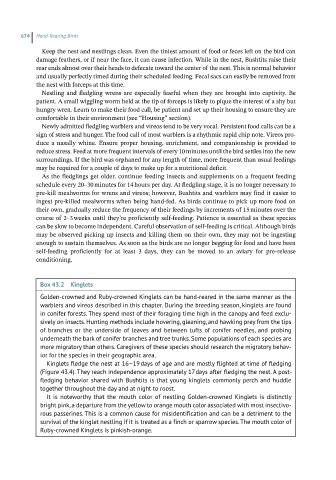Page 673 - Hand rearing birds second
P. 673
674 Hand-Rearing Birds
Keep the nest and nestlings clean. Even the tiniest amount of food or feces left on the bird can
damage feathers, or if near the face, it can cause infection. While in the nest, Bushtits raise their
rear ends almost over their heads to defecate toward the center of the nest. This is normal behavior
and usually perfectly timed during their scheduled feeding. Fecal sacs can easily be removed from
the nest with forceps at this time.
Nestling and fledgling wrens are especially fearful when they are brought into captivity. Be
patient. A small wiggling worm held at the tip of forceps is likely to pique the interest of a shy but
hungry wren. Learn to make their food call, be patient and set up their housing to ensure they are
comfortable in their environment (see “Housing” section).
Newly admitted fledgling warblers and vireos tend to be very vocal. Persistent food calls can be a
sign of stress and hunger. The food call of most warblers is a rhythmic rapid chip note. Vireos pro-
duce a nasally whine. Ensure proper housing, enrichment, and companionship is provided to
reduce stress. Feed at more frequent intervals of every 10 minutes until the bird settles into the new
surroundings. If the bird was orphaned for any length of time, more frequent than usual feedings
may be required for a couple of days to make up for a nutritional deficit.
As the fledglings get older, continue feeding insects and supplements on a frequent feeding
schedule every 20–30 minutes for 14 hours per day. At fledgling stage, it is no longer necessary to
pre‐kill mealworms for wrens and vireos; however, Bushtits and warblers may find it easier to
ingest pre‐killed mealworms when being hand‐fed. As birds continue to pick up more food on
their own, gradually reduce the frequency of their feedings by increments of 15 minutes over the
course of 2–3 weeks until they’re proficiently self‐feeding. Patience is essential as these species
can be slow to become independent. Careful observation of self‐feeding is critical. Although birds
may be observed picking up insects and killing them on their own, they may not be ingesting
enough to sustain themselves. As soon as the birds are no longer begging for food and have been
self‐feeding proficiently for at least 3 days, they can be moved to an aviary for pre‐release
conditioning.
Box 43.2 Kinglets
Golden-crowned and Ruby-crowned Kinglets can be hand-reared in the same manner as the
warblers and vireos described in this chapter. During the breeding season, kinglets are found
in conifer forests. They spend most of their foraging time high in the canopy and feed exclu-
sively on insects. Hunting methods include hovering, gleaning, and hawking prey from the tips
of branches or the underside of leaves and between tufts of conifer needles, and probing
underneath the bark of conifer branches and tree trunks. Some populations of each species are
more migratory than others. Caregivers of these species should research the migratory behav-
ior for the species in their geographic area.
Kinglets fledge the nest at 16–19 days of age and are mostly flighted at time of fledging
(Figure 43.4). They reach independence approximately 17 days after fledging the nest. A post-
fledging behavior shared with Bushtits is that young kinglets commonly perch and huddle
together throughout the day and at night to roost.
It is noteworthy that the mouth color of nestling Golden-crowned Kinglets is distinctly
bright pink, a departure from the yellow to orange mouth color associated with most insectivo-
rous passerines. This is a common cause for misidentification and can be a detriment to the
survival of the kinglet nestling if it is treated as a finch or sparrow species. The mouth color of
Ruby-crowned Kinglets is pinkish-orange.

